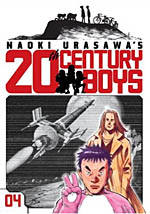 By Naoki Urasawa
By Naoki Urasawa
216 pages, black and white
Published by Viz
It’s hard to believe that it was just earlier this spring when I first encountered the opening volume of 20th Century Boys. That first book, about the mystery of a former school mate who started a cult, drew me right into the series and made me want to read more. Now that I’m on the fourth volume, though, I find myself amazed at all of the surprises that Naoki Urasawa has unleashed upon his characters since that first book. To say that this is a series that keeps getting better and better is an understatement—and we’re only 1/6th of the way through the entire saga.
When Kenji and his friends wrote the Book of Prophecy back in 1969, it was just a game they were playing about the end of the world. In the late 1990s, though, the events of the book are coming to life with terrifying accuracy. It’s all thanks to the mysterious "Friend," the leader of a cult who is using the Book of Prophecy as a guidebook for one horrific event after another. With Kenji and his family now hiding underground, and the cult of Friend growing by the day, all looks lost. But can an old classmate now known as Shogun help turn the tide?
The bulk of the latest volume follows Shogun, the mysterious former classmate of Kenji’s who now lives in Bangkok’s slums and helps those in need. At first you might be a little irritated for the story to have jumped so far away from the action, but any feelings will swiftly fade. Not only does the reach of Friend go much further than you might suspect, but Shogun is a compelling and interesting character in his own right. There’s a moment at the halfway point of this volume where Shogun explains why he’s so fearless, and it’s a moment that hits the reader hard. It’s not necessarily the fact that it’s a sad and grim moment in Shogun’s past, but rather the level of emotion and life-changing turmoil that it caused for Shogun. It’s a strong, gut-wrenching speech, the sort of thing that you can’t help but hope the planned movie version of 20th Century Boys nails. It’s really the centerpiece of this volume, and from that point on Shogun becomes one of the most interesting characters in the series.
What I also love about 20th Century Boys, and even more so with each volume, is that Urasawa is able to keep upping the ante with each new machination of Friend and his followers. It’s the channeling of the imagination of a young child, but tempered through the craft of an adult. Having Friend and his followers try and turn each of these events into reality is a fascinating cross of science, science-fiction, and even a touch of humor. The scientists and inner council arguing over how a massive robot could be built is awfully funny, or at least until the reminder comes across on exactly what Friend has in mind for the robot being built. Even something as simple as an attempted rescue of a scientist’s hostage daughter comes across as a great twist on the normal sort of story you’d expect to be told; there’s a bit of humor, but generally speaking it’s an imaginative, smart story.
Urasawa’s art in 20th Century Boys is as good and solid as ever. This is someone who can draw a room full of squabbling scientists at a conference room table and make it seem non-static and interesting. I especially love when Urasawa flashes back to the ’60s and we see his characters as young children, perhaps because they’re both instantly recognizable as their younger selves and also more than just a short version of an adult. It’s that level of care and commitment to the art, mapping out what characters would look like at different ages, that is rapidly becoming a hallmark of Urasawa’s art. He’s not just a good writer, he’s an excellent artist to boot. Some people, it seems, do have it all.
How can you defeat someone who is perpetually one step ahead of you? It’s a question that Kenji and Shogun are trying to answer, but four volumes in, Friend holds all the aces. 20th Century Boys as well as Pluto are two of Urasawa’s greatest series to date, and immediately go to the top of my "to read" pile as soon as I get hold of a new volume. Check it out, but I promise you, the chances of you getting instantly hooked are awfully high as well. Highly recommended.
Purchase Links: Amazon.com | Powell’s Books
